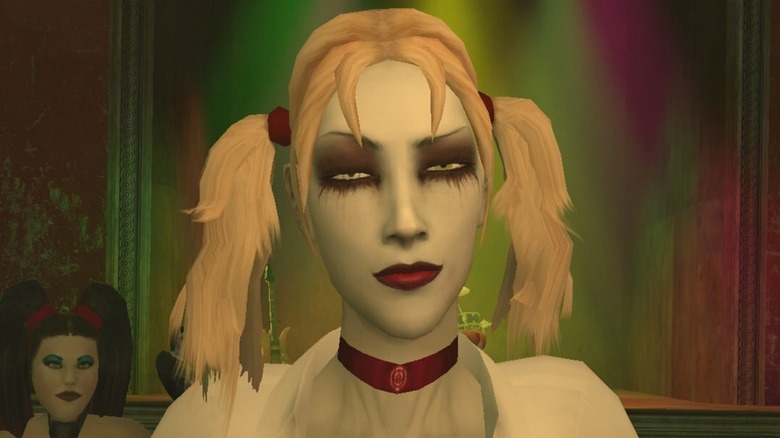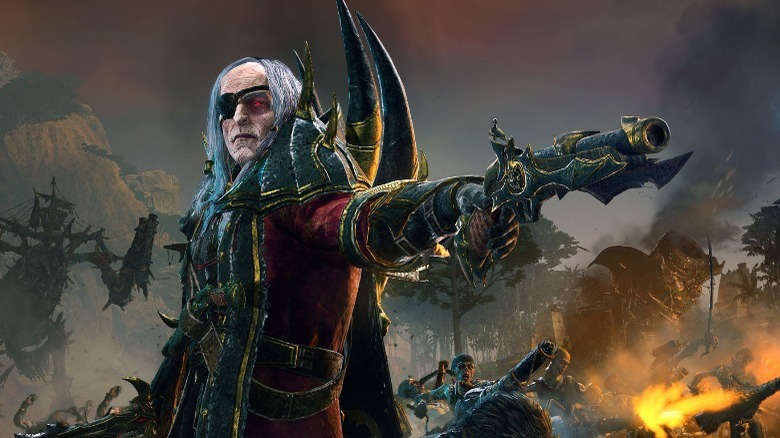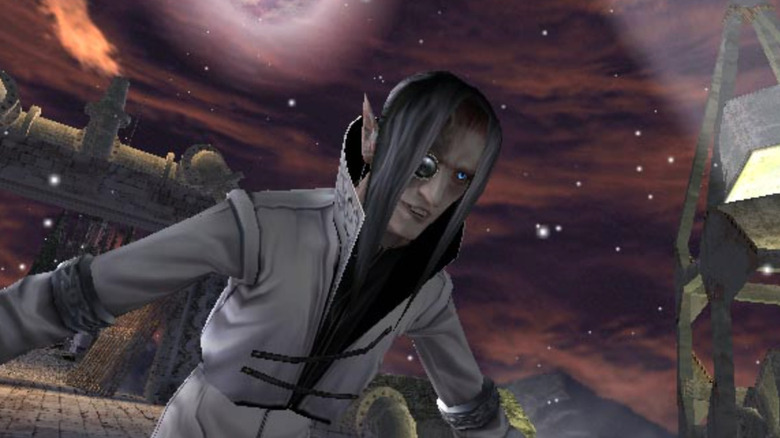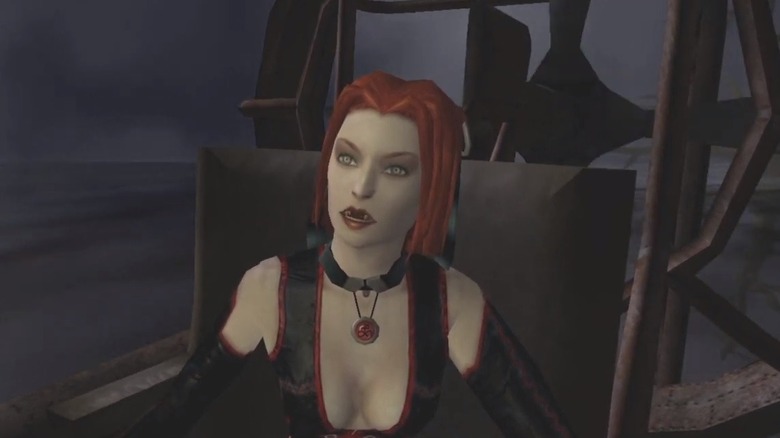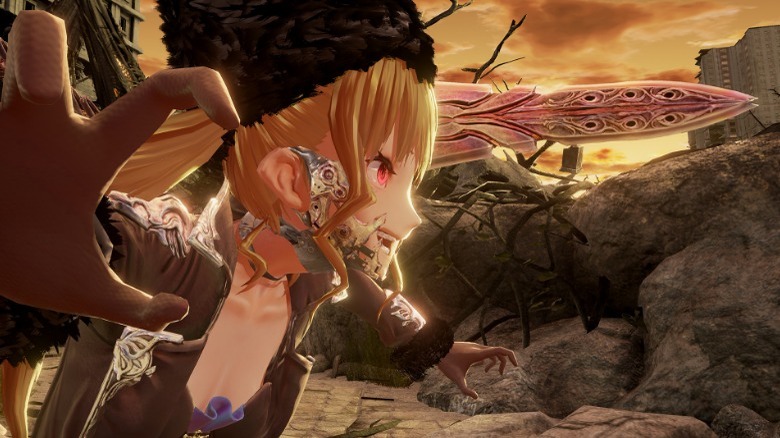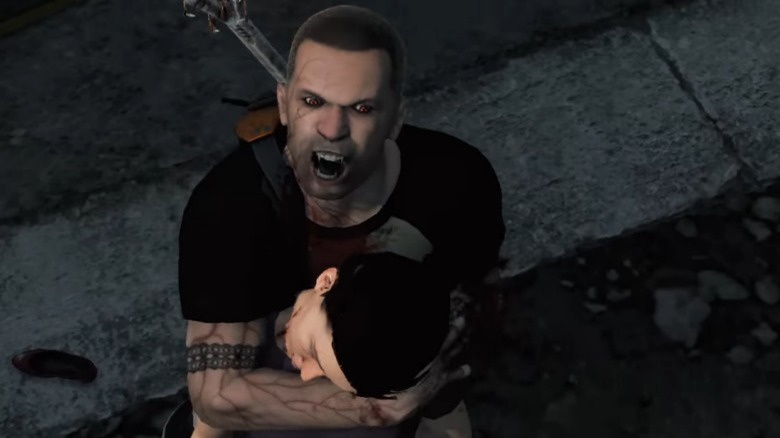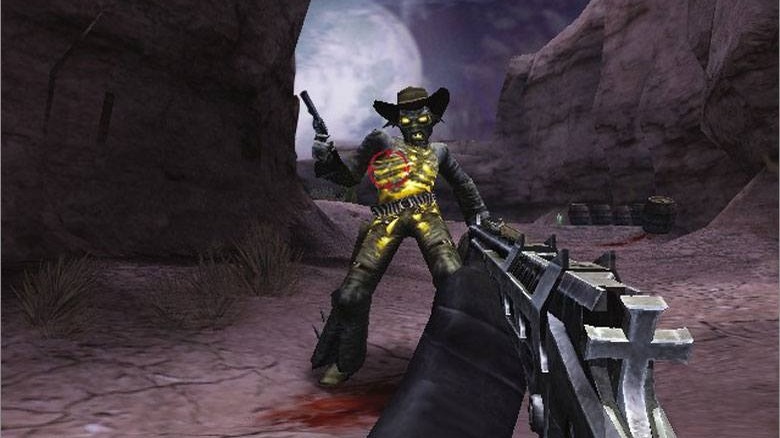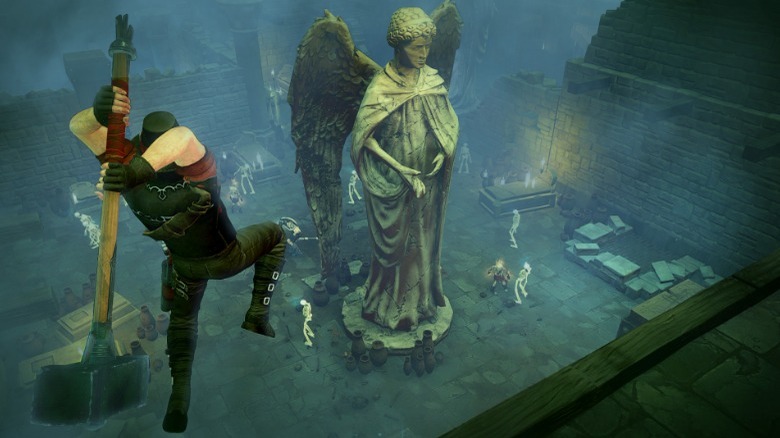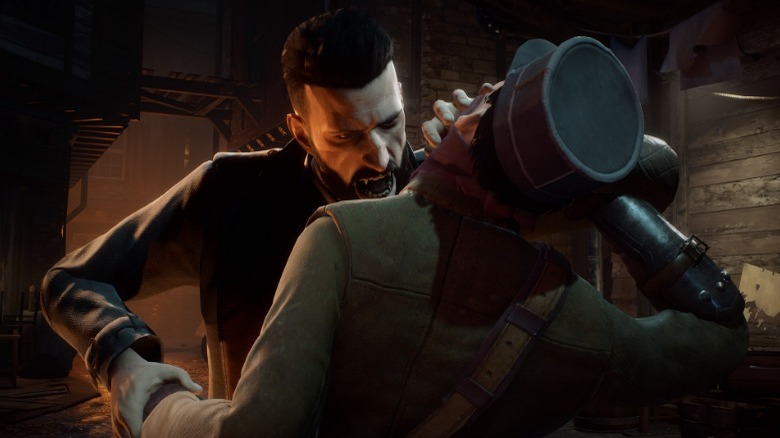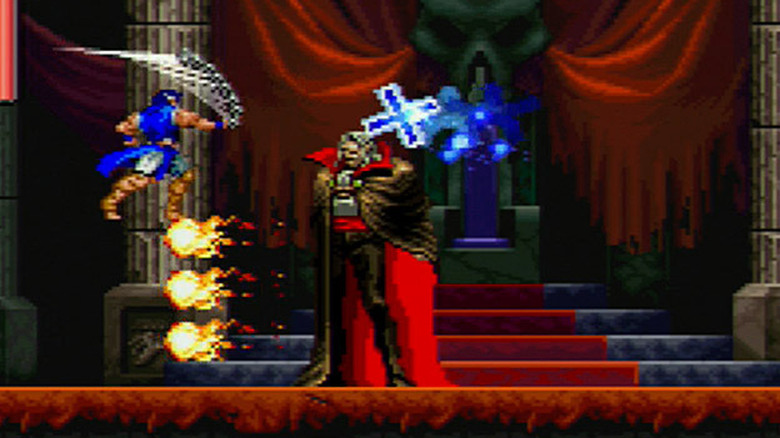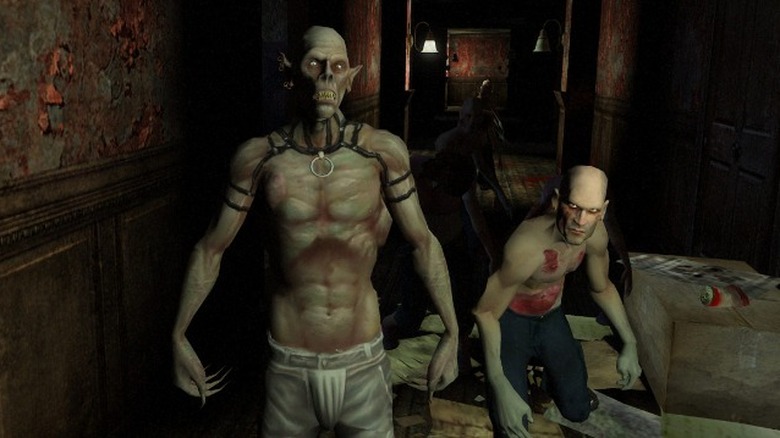The 10 Best Vampire Games Of All Time Ranked
The popularity of vampires is as immortal as the creatures themselves. The world of entertainment is full of fictional bloodsuckers and covers a wide swathe of genres. You've got the rich and varied history of vampires in Marvel comics, the seminal Quentin Tarantino/Robert Rodriquez bloodbath "From Dusk Till Dawn," and Taika Waititi's mockumentary "What We Do in the Shadows." And of course, plenty of video games are based on the children of the night.
Vampires make for popular video game fodder, as nothing solidifies a hero's legacy quite like slaying a legion of them. But every so often, a video game revolves around vampires and lets them either sit in the final boss' chair or wear the protagonist's shoes. These games put vampires in the spotlight and can transform into fascinating character studies that delve into the nature of vampirism and evil — or they can suck more than an actual vampire. As with all pieces of media, not all vampiric video games are equal. Some are regarded as quintessential classics that every red-blooded gamer needs on their bucket list, while others are messes that are best left in the crypt of forgotten games.
Given the sheer number of video games out there, many gamers might be hard-pressed to find good games about vampires, so here's an easy list of 10 great titles you can play while you are waiting for upcoming vampire games like "Redfall" and "Vampire: The Masquerade – Bloodlines 2" — assuming you can stake out a copy, that is.
Honorable Mention - Total War: Warhammer
Fantasy worlds filled with dragons and elves also tend to feature legions of undead, and the "Warhammer" fantasy franchise is no different. While this classic setting sports many prominent living armies such as Dwarfs, Humans, and Orcs, it also features undead forces, including the Vampire Counts.
As the name suggests, "Total War: Warhammer" is a "Warhammer"-themed entry in Creative Assembly's long-running "Total War" series. The game features the series-standard strategic warfare, lengthy campaigns, and negotiation tactics, just with a fantasy paint-job. Moreover, each army utilizes unique strategies and tech trees. For instance, the Vampire Counts, when played out of the box, tend to bury enemies under a tidal wave of bones and rotting flesh. They make up for a lack of ranged weapons with a ton of flying units and the ability to make skeletons literally jump out of enemy skins and beat the living to death with rusty swords.
"Total War: Warhammer" also follows the proud "Total War" tradition of building on previous entries with DLC and sequels. Each new game is compatible with older titles and includes new units, campaigns, armies, and reworks. "Total War: Warhammer 2," for example, introduced the series' second vampire army, the Vampire Coast, via DLC. Unlike the classic gothic creeps of the Vampire Counts, this army is a legion of vampire pirates backed by waterlogged zombies, mammoth-sized hermit crabs, and cannibalistic torsos.
"Total War: Warhammer" is an honorary vampire game, since its undead armies are outnumbered by living forces such as Elves, Dwarfs, and Lizardmen. Still, it's a great game any strategy fan should check out.
10. Vampire Night
Light gun games are good, clean fun that ferry players through linear corridors, let them shoot legions of enemies, and encourage them to shovel quarters into coin slots when they inevitably die. These experiences emphasize short, bombastic action, and it's difficult to mess them up. It's also difficult to find a light gun game that doesn't have to do with zombies or gun-wielding terrorists/robots, but "Vampire Night" is one such title.
"Vampire Night" — not to be confused with the anime "Vampire Knight" — is a simple light gun adventure that plays like "House of the Dead," partially because they were developed by the same company, WOW Entertainment. As noted by GameSpot, "Vampire Night” doesn't innovate much from the standard formula of "shoot bad guy to not die;" even the game's vampires function identically to zombies in "House of the Dead." "Vampire Night" only truly innovates in the rescuable civilians department. Instead of saving cowering piles of polygons from encroaching enemies, these NPCs are the enemies. Each civilian is infected with a pustule that must be shot off with pixel-perfect accuracy, all while they slowly shuffle towards players. Hit the NPC instead of the pustule, and they mutate into a powerful enemy and penalize the score.
What "Vampire Night" lacks in innovation, it makes up for in presentation and action. Like many light gun titles, the game is a fun and frantic blast from start to finish, and it maintains the awful voice acting and hammy, barebones storytelling "House of the Dead" fans know and love. At only 48 minutes, "Vampire Night" doesn't overstay its welcome, either; the game challenges players with slick and enjoyable shooting galleries and then slips back into the memory hole it came from.
9. BloodRayne series
Long before "Twilight" convinced audiences that vampires should be introspective teenage heartthrobs, the en vogue fashion for vampires was a mix of leather and edge. This trend influenced and birthed many vampire properties, including the video game franchise "BloodRayne."
"BloodRayne" is a series of two 3D hack-and-slash titles (and one side-scroller) originally published by Majesco. The games are a product of their time: They star Rayne, a leather-wearing half-vampire who sucks most enemies dry for health and kickflips everyone else's heads off. The series focuses on fast action that puts the "gore" in "gorgeous," albeit with camera jank typical of games published in the early 2000s.
The first "BloodRayne" game is narratively uncluttered and mostly focuses on battling inhuman monsters such as demons and Nazis — and looking good while doing so. While the sequel unfortunately removes Nazis from the picture (you can never defeat too many in video games), it makes up for that shortcoming with a stronger story that focuses on Rayne's evil vampiric family, as well as even better combat. The third and final game, "BloodRayne: Betrayal," is an odd beast that trades 3D graphics for beautiful 2D assets. While "Betrayal" has the weakest story of the bunch, it delivers a stylish, combo-driven combat system that encourages players to beat their own high scores.
While the "BloodRayne" franchise has been in hibernation since 2011, partially (if not mostly) because of the abysmal Uwe Boll films based on the games, Ziggurat has resurrected the franchise with updated rereleases compatible with modern operating systems and controllers. The age of leather-clad vampires may be dead, but "BloodRayne" lives on.
8. Code Vein
After Bandai Namco hit it big by publishing "Dark Souls," virtually every game company wanted to make the next big "Souls"-like — including Bandai Namco. However, mimicking gameplay mechanics and systems is only half the challenge; the game's aesthetics must stand out from the inspiration. This need to differentiate resulted in games like Focus Home Interactive's sci-fi hellscape "The Surge," Koei Tecmo's samurai-themed "Nioh," and Bandai Namco's vampire anime adventure "Code Vein."
In "Code Vein," players control protagonists that are vampires in everything but name. They might be called "revenants," but their supernatural powers and need for blood makes them vampires...who can turn their jackets into blood-sucking scorpion tails and dog heads. "Code Vein" sports many hallmarks of a "Souls"-like, such as stamina-based combat and experience points that drop on death, but it also sets itself apart with a robust mix-and-match skill class system and competent AI partners. Also, the character creator lets gamers build the gaunt, cat ear-wearing vampires of their dreams.
"Code Vein" also offers a surprisingly overt story for a "Souls"-like, although some critics were less than impressed by the narrative. Whether or not players see it to the end is a completely different matter, since the game's levels are uninspired and loading times border on glacial. Furthermore, while "Code Vein" can be difficult, it isn't quite as controller-throwingly challenging as "Dark Souls."
"Code Vein" isn't the best "Souls"-like out there, but its unique anime charm, as well as additions such as classes and NPC allies, might help it stick in gamers' memories longer than others.
7. Infamous: Festival of Blood
When used properly, DLC can offer developers a unique opportunity to expand on a game's narrative without spending the time and resources required to build a proper sequel. Or studios can go absolutely cuckoo-bananas and tell an off-the-rails story they never could in the main game. When almost anything is fair game, why not insert vampires?
"Infamous: Festival of Blood" is a standalone expansion for "Infamous 2" that takes place over the course of one non-canonical night. Protagonist Cole MacGrath has been bitten by a vampire and needs to fight for ownership of his soul. The DLC lets players blast countless bloodsuckers, all while exploring districts from "Infamous 2" that have undergone a Halloween makeover. And since Cole is turning into the undead, he has access to several new abilities, such as the power to explode into a cloud of flying bats and to see the world through the altered perception of a vampire.
While many gamers might assume that new powers are good, they must remember that — like all things vampiric — these additions come at a cost. Cole has to keep his belly full of blood, which he can acquire by staking fellow vampires or feeding on innocent civilians. This is the DLC's first problem: It is devoid of the franchise's distinct morality system. Moreover, Cole doesn't have access to his full array of normal electric powers, and most players take no more than six hours to see everything the expansion has to offer.
"Infamous: Festival of Blood" ultimately prescribes to a "quality over quantity" mentality. There's not much to the game, but what's available stands head and shoulders above its contemporaries.
6. Darkwatch: Curse of the West
The Weird West is an underappreciated genre that inserts supernatural elements, steampunk technology, and the occasional dinosaur into the Wild West. While the trope has existed for quite a while in movies and shows, video games have struggled to catch up. One game tried to change all that with vampires, only to become a cult classic instead of a success.
"Darkwatch: Curse of the West," the first game produced by High Moon Studios, is nothing if not unique. Players control an outlaw who unwittingly releases a powerful vampire during a train robbery gone wrong. As "thanks," the vampire bites the protagonist, who then must use his burgeoning vampiric powers and an array of firearms to slay hordes of the undead and eventually lift his curse — or supplant the vampire as a new lord of the undead.
Reviews have noted that "Darkwatch" is both a product of its time (for good and bad) and a novel experience. On one hand, the game channels all the first-person shooter style of early "Halo" — two weapon limit, regenerating shield with non-regenerating health, and slick controls — and also adopts binary morality choices that affect the ending and what vampiric powers players can use. On the other hand, the story of "Darkwatch" isn't particularly deep, and its characters, especially the women, are underserved by the narrative, coming off one-note and cliched.
High Moon Studios had high hopes for "Darkwatch." The company wanted to turn it into a multimedia juggernaut, complete with sequels and movies (per IGN), but all those plans dried up. Still, the game is worth playing if you can find a copy for Xbox or PS2.
5. Victor Vran
When you hear "Van Helsing," you automatically assume vampires are involved. It's only natural, since the name originates from the novel "Dracula," the grandfather of all modern vampire media. So, surely "The Incredible Adventures of Van Helsing," a loot-based dungeon crawler that stars the fictional character's son, would feature vampires. After all, vampire hunting is in his blood. Nope. Instead, fans need to get that thrill from an unrelated "Diablo"-like game, "Victor Vran."
For those who have never heard of the game, "Victor Vran" is a solidly-reviewed ARPG with no class. Literally. Players control the titular Victor Vran (voiced by Geralt of Rivia himself, Doug Cockle), whose skills are completely dependent on the weapons he wields, as well as collectible demonic powers. Throughout the game, players and Victor delve into all manner of crypts and castles to slaughter various evil creatures. While players start off killing Spiders of Unusual Size, they eventually work their way up to massacring vampires. The narrative is fairly straightforward, if not cliched, but one of the game's main characters — a disembodied voice fittingly known as "The Voice" — provides some surprising levity, and most gamers will probably laugh at some of his lines.
While "Victor Vran" isn't the most well-known of games, you probably have heard of its DLC patron. The game's main story expansion, "Motörhead: Through the Ages," spirits Victor into a world right out of a Motörhead album — and backed by one, too. The DLC is a love letter to the heavy metal band and its late founder, Lemmy Kilmister, and adds new enemies, areas, and equipment. If you ever wanted to slay demons and vampires with a weaponized guitar, now's your chance.
4. Vampyr
Many games with multiple endings rely on simple choices, like "Do you rescue character A or character B?" These finale-altering decisions are often as telegraphed as they are binary, but "Vampyr" tries things differently.
"Vampyr" casts players in the role of a vampire, specifically a military surgeon-turned-vampire, fresh off his tour of duty in World War 1. To pile on the irony, he's a blood specialist, and his hometown of London is in the grip of the Spanish Flu. Or is it? That's the game's narrative hook, but its true strength is the ability to sink its fangs into the risk-vs-reward part of the brain.
Like many RPGs, "Vampyr" lets players level up through fighting enemies, but the best source of experience points is NPCs. Each character is well-written and intimately tied into the world. More importantly, there's only a finite number of characters to snack on. This system turns "Vampyr" into a societal ties simulator. The more players get to know an NPC, the more EXP they're worth when drained of blood, and the more relatable they become. On one hand, gamers might want to kill as few NPCs as possible, but that would leave the main character severely underleveled. On the other hand, treating side characters like experience-laden juice boxes keeps the protagonist flush with skills and power, but turns London into a lawless slum riddled with disease and mindless ghouls.
"Vampyr" is a tightrope of decisions as players try to stay sufficiently leveled while also keeping the streets relatively safe. The game is only occasionally brought down by the odd typo or bad performance, but that's a small price to pay for such an otherwise immersive experience.
3. Castlevania: Symphony of the Night
The "Castlevania" series couldn't separate itself from vampires if it tried. Most entries feature Dracula (or some reincarnation) as the final boss, but even when he's absent, vampires are always a featured enemy. "Castlevania" has so many games, especially good ones, so why not just go for the cream of the crop: "Castlevania: Symphony of the Night."
You would be hard-pressed to find a gamer who hasn't heard of "Symphony of the Night." The game single-handedly reinvented the "Castlevania" franchise. Gone were insular levels that focused on platforming, replaced by a large, explorable castle. Instead of the familiar whip-wielding Belmont, players could control Dracula's son, Alucard, and collect all manner of weapons and abilities to slice open ever more powerful enemies and plunge darker castle depths. This "Metroid"-esque style of progression coined — and popularized — the "Metroidvania" genre.
After "Symphony of the Night" released to critical acclaim, Konami used the game as a blueprint for future "Castlevania" titles. Most subsequent entries copied the game's best elements, at times almost note-for-note. However, despite the following "Castlevania" games iterating on the formula, "Symphony of the Night" still pulls its own weight and entertains audiences today. Something about the game's action, aesthetics, and soundtrack defy the march of time.
If "Castlevania: Symphony of the Night" has any weaknesses, it's the game's laughable dialogue and voice acting. Even so, audiences are obviously forgiving of these flaws, given the sheer number of memes people have made with associated audio and video clips. Some memes are forgotten quickly, but "Symphony of the Night" memes are more undying than Dracula himself.
2. Legacy of Kain series
Many developers love to make their games feel more cinematic. Some use camera angles and screen ratios usually reserved for movies, while others cast prominent actors in video game roles. What game kickstarted this obsession with making games so cinematic? It wasn't "Metal Gear Solid," that's for sure.
Some gamers have pointed to "Legacy of Kain: Blood Omen" as the first video game to mix quality voice acting with a meaty narrative, and the "Legacy of Kain" franchise proudly continued that trend with every subsequent entry save one (more on that later). The story of "Blood Omen" continued with a different time period and protagonist in "Legacy of Kain: Soul Reaver" and eventually culminated in "The Legacy of Kain: Defiance." While you have to play almost every game in the series to fully appreciate the time-twisting scope of the narrative, it is well worth the journey, as the series' overarching plot is arguably one of the finest in video game history.
Of course, because the "Legacy of Kain" story is told over several games, quality ebbs and flows with each entry. For instance, "Blood Omen" started the series with a bird's-eye perspective, but "Soul Reaver" hurled the franchise into the third dimension, complete with the poor controls and infuriating platforming sections typical of early 3D games. Meanwhile, "Legacy of Kain: Blood Omen 2" is widely regarded as the low point of the series because of its repetitive combat, braindead puzzles, and bland story.
Vampire novels like "Dracula" are some of the best stories ever written, so it's only fitting that a vampire series like "Legacy of Kain" would claim a similar apex niche in the world of video games.
1. Vampire: The Masquerade - Bloodlines
Development has not been kind to "Vampire: The Masquerade – Bloodlines 2." First the game was delayed until 2020, then until 2021, and now indefinitely. This news disappointed many gamers, especially because the previous entry in the series, "Vampire: The Masquerade – Bloodlines," has been considered the best vampire game of all time. Then again, just as many gamers expected "Bloodlines 2" to be delayed, considering the series' cursed legacy.
"Vampire: The Masquerade – Bloodlines" is hailed by gamers as a masterclass in video game writing and RPG design. Not only are characters beautifully realized by a mix of clever banter and near-flawless deliveries, the game's world is brought to life by its tiniest details. However, writing is only part of the game's appeal.
If you could sum up "Bloodlines" in one word, it would be "replayable." Many gamers who finish the title find themselves compelled to play again. "Bloodlines" is based on the tabletop RPG "Vampire: The Masquerade" and translates the book's rules almost flawlessly into digital form. Players have a variety of stats and abilities to choose from, which impact how they complete missions. While each of the game's vampire clans (essentially classes) are predisposed to certain skills and tactics, some offer hilariously unique events. For instance, if you ever wanted to have an argument with a stop sign, you need to play as a Malkavian.
"Vampire: The Masquerade – Bloodlines" had to earn its current esteemed status. The game launched in a buggy, incomplete state due to development troubles, and many gamers can't experience all it has to offer without unofficial patches. Thankfully, the GOG.com version comes with all of those pre-installed.

